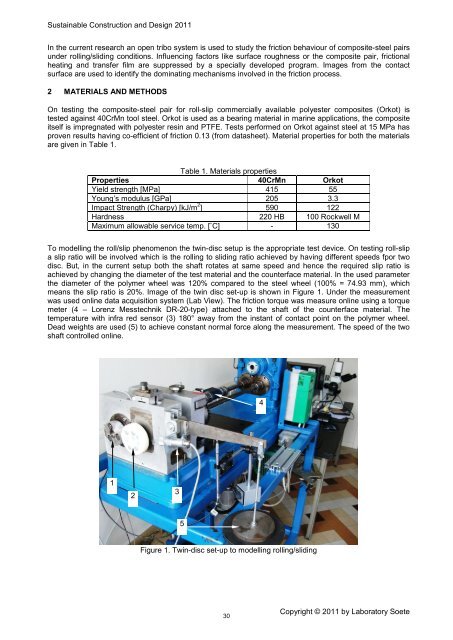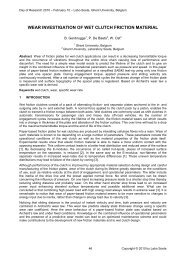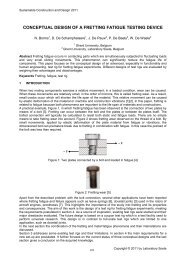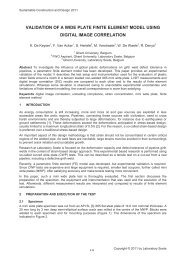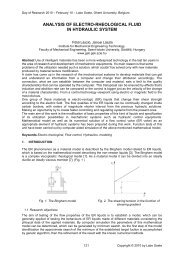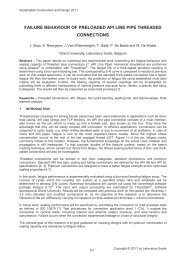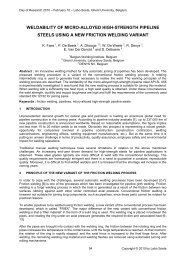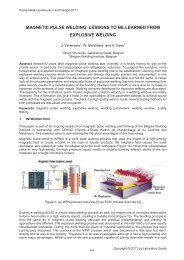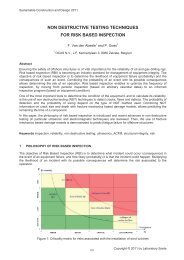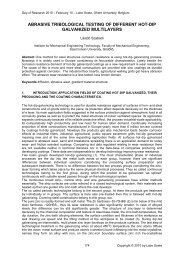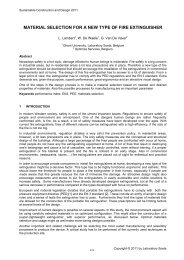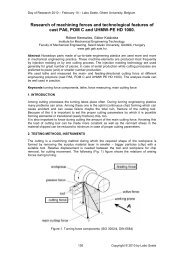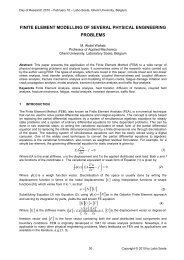Volume 2, Issue 1, 2011, Full Text - 5th International Conference on ...
Volume 2, Issue 1, 2011, Full Text - 5th International Conference on ...
Volume 2, Issue 1, 2011, Full Text - 5th International Conference on ...
You also want an ePaper? Increase the reach of your titles
YUMPU automatically turns print PDFs into web optimized ePapers that Google loves.
Sustainable C<strong>on</strong>structi<strong>on</strong> and Design <str<strong>on</strong>g>2011</str<strong>on</strong>g><br />
In the current research an open tribo system is used to study the fricti<strong>on</strong> behaviour of composite-steel pairs<br />
under rolling/sliding c<strong>on</strong>diti<strong>on</strong>s. Influencing factors like surface roughness or the composite pair, fricti<strong>on</strong>al<br />
heating and transfer film are suppressed by a specially developed program. Images from the c<strong>on</strong>tact<br />
surface are used to identify the dominating mechanisms involved in the fricti<strong>on</strong> process.<br />
2 MATERIALS AND METHODS<br />
On testing the composite-steel pair for roll-slip commercially available polyester composites (Orkot) is<br />
tested against 40CrMn tool steel. Orkot is used as a bearing material in marine applicati<strong>on</strong>s, the composite<br />
itself is impregnated with polyester resin and PTFE. Tests performed <strong>on</strong> Orkot against steel at 15 MPa has<br />
proven results having co-efficient of fricti<strong>on</strong> 0.13 (from datasheet). Material properties for both the materials<br />
are given in Table 1.<br />
Table 1. Materials properties<br />
Properties 40CrMn Orkot<br />
Yield strength [MPa] 415 55<br />
Young’s modulus [GPa] 205 3.3<br />
Impact Strength (Charpy) [kJ/m 2 ] 590<br />
122<br />
Hardness 220 HB 100 Rockwell M<br />
Maximum allowable service temp. [˚C] - 130<br />
To modelling the roll/slip phenomen<strong>on</strong> the twin-disc setup is the appropriate test device. On testing roll-slip<br />
a slip ratio will be involved which is the rolling to sliding ratio achieved by having different speeds fpor two<br />
disc. But, in the current setup both the shaft rotates at same speed and hence the required slip ratio is<br />
achieved by changing the diameter of the test material and the counterface material. In the used parameter<br />
the diameter of the polymer wheel was 120% compared to the steel wheel (100% = 74.93 mm), which<br />
means the slip ratio is 20%. Image of the twin disc set-up is shown in Figure 1. Under the measurement<br />
was used <strong>on</strong>line data acquisiti<strong>on</strong> system (Lab View). The fricti<strong>on</strong> torque was measure <strong>on</strong>line using a torque<br />
meter (4 – Lorenz Messtechnik DR-20-type) attached to the shaft of the counterface material. The<br />
temperature with infra red sensor (3) 180° away from the instant of c<strong>on</strong>tact point <strong>on</strong> the polymer wheel.<br />
Dead weights are used (5) to achieve c<strong>on</strong>stant normal force al<strong>on</strong>g the measurement. The speed of the two<br />
shaft c<strong>on</strong>trolled <strong>on</strong>line.<br />
4<br />
1<br />
2<br />
3<br />
5<br />
Figure 1. Twin-disc set-up to modelling rolling/sliding<br />
30<br />
Copyright © <str<strong>on</strong>g>2011</str<strong>on</strong>g> by Laboratory Soete


